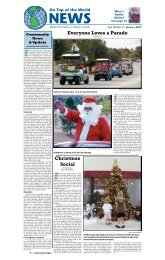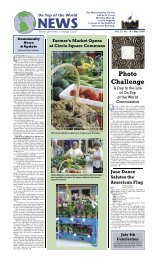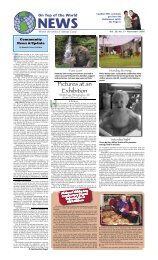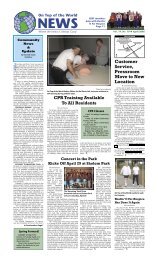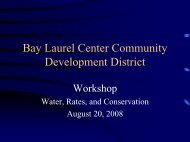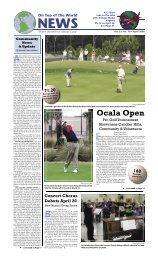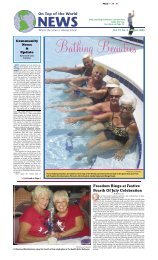10 The <strong>World</strong> News® <strong>September</strong> <strong>2009</strong>NativePlant GroupRon BromanThe male Monarch hovers near <strong>the</strong>Knock-out Rose. If butterflies think, Iwonder what he’s planning. Newly arrivedto our garden <strong>of</strong> weedin’, he’s not alone.Some force, not much understood, hasplaced <strong>the</strong>m here. It’s migration time.I watch through binoculars as he lightsand begins feeding, not on <strong>the</strong> exotic rosebut on <strong>the</strong> native Narrowleaf Ironweed.Nearby <strong>the</strong> female floats, <strong>the</strong>n <strong>of</strong>f <strong>the</strong>ywhirl in a narrow vortex, perhaps to someclose rendezvous.So far, this tale is incomplete. You knowthat in <strong>the</strong> cycle <strong>of</strong> butterflies, two types<strong>of</strong> plants are required:food foradult and foodfor <strong>the</strong> larvae( c a t e r p i l l a r ) .Monarch familycaterpillarsfeed on plantsin <strong>the</strong> Milkweed(Asclepias) family.I’ve alreadywritten abouttwo species <strong>of</strong>Asclepias nativeto our area:A. tuberosa andA. humistrata.A third, LongleafMilkweed,A. longifolia,is native to <strong>the</strong>sou<strong>the</strong>asternU.S., including Florida, although ra<strong>the</strong>rrare.Longleaf Milkweed has few stems and,unlike o<strong>the</strong>r milkweeds, its three to seveninch leaves are as narrow as blades <strong>of</strong>grass. Its umbel <strong>of</strong> small white blossomsprovides that “milkweed look.” Later,<strong>the</strong> characteristic pod forms, containing<strong>On</strong> <strong>Top</strong> <strong>of</strong> <strong>the</strong> <strong>World</strong>NEWS9850 SW 84th Court, Suite 300Ocala, FL 34481those seeds with “<strong>the</strong> little parachute.”It’s a milkweed all right.Longleaf Milkweed occurs in “seasonallyflooded flatwoods and likely is adaptableto many typical home landscapesettings.” Guess what! This milkweed isblooming now along our <strong>On</strong> <strong>Top</strong> <strong>of</strong> <strong>the</strong><strong>World</strong> Longleaf Pine Trail, and <strong>the</strong> habitatis a high and dry sand hill. Could it bethat it is not longifolia?It’s time to check with my mentor,Robert Riedeman, who has that specialbook, <strong>the</strong> Guide to <strong>the</strong> Vascular Plants <strong>of</strong>Florida, second edition, (2003) by Wunderlinand Hansen.Look at this close-up picture <strong>of</strong> <strong>the</strong>white inflorescence, <strong>the</strong> spent umbel with<strong>the</strong> newly forming seedpods and <strong>the</strong> narrowleaves. The blooms are half <strong>the</strong> size<strong>of</strong> a dime, but part <strong>of</strong> <strong>the</strong> clue is <strong>the</strong>re, <strong>the</strong>length <strong>of</strong> <strong>the</strong> internal flower parts. Ano<strong>the</strong>rclue is that <strong>the</strong> leaves as <strong>the</strong>y connectto <strong>the</strong> stem are nei<strong>the</strong>r opposite each o<strong>the</strong>rnor alternately placed but are whirledaround <strong>the</strong> stem. There is only one milkweedthat meets <strong>the</strong>se attributes; Asclepiasverticillata or Whirled Milkweed.Our two Monarchs are back “cruising”<strong>the</strong> garden.If our Gopher Tortoises and <strong>the</strong> o<strong>the</strong>rcritters allow A. verticillata to mature,next season mama Monarch’s Floridaprogeny may find <strong>the</strong> leaves <strong>of</strong> <strong>the</strong>Whirled Milkweed’s progeny a suitablesource <strong>of</strong> food.I just wonder if that’s what papa Monarchis contemplating.Summer is just about to usher in anew season forour Native PlantGroup. Oct. 14,Guda and DaveTaylor <strong>of</strong> TaylorGardens Nurserybegin with<strong>the</strong> extremelypopular NativePlant raffle.They’re sure tohave some winningspeciesand informationespeciallyfor you.Our programsare <strong>the</strong>second WednesdayOctober,November andfrom Januarythrough May, at1:45 p.m. in <strong>the</strong> Arbor Conference Center,Suite H. In addition to learning about nativeplants, you are provided informationon how to become more “in <strong>the</strong> know”about conservation issues in MarionCounty and beyond. Come join us as toge<strong>the</strong>rwe grow native.Photo by Ron BromanWhirled Milkweed (Asclepias verticillata)on <strong>the</strong> Longleaf Pine Trail.Submit Articles by E-mail tootownews@otowfl.comAll you great folks who enjoyed <strong>the</strong>second Art <strong>of</strong> Bonsai Exhibition in Marchat <strong>the</strong> Education Building will have ano<strong>the</strong>ropportunity to not only view Bonsaiavailable for purchase, but also to lookover a few books that will be available aswell as tools, lovely pots <strong>of</strong> all sizes andalso get some first-hand information thatwill help you see if this art is somethingyou think youwould enjoy!This BonsaiAuction isa yearly eventthat helps <strong>the</strong>Marion BonsaiSociety fur<strong>the</strong>r<strong>the</strong> educationand interest <strong>of</strong>many people,including highschool studentsas we didrecently withWestport HighSchool. If youattended <strong>the</strong>Bonsai Auctionrecent showhere at <strong>On</strong> <strong>Top</strong><strong>of</strong> <strong>the</strong> <strong>World</strong>,<strong>the</strong> class displayedwhat<strong>the</strong> horticulturestudentshad accomplished since <strong>the</strong>ir classes, instructedby Don McLean and David van-Buskirk, who are members <strong>of</strong> <strong>the</strong> society.After <strong>the</strong>y were judged, Tom Brantleyand <strong>the</strong> students retired to <strong>the</strong> classroomwith <strong>the</strong>ir Bonsai trees for a critique <strong>of</strong>Orchid ClubLinda Rose<strong>September</strong> <strong>2009</strong> marks <strong>the</strong> fourth yearfor <strong>On</strong> <strong>Top</strong> <strong>of</strong> <strong>the</strong> <strong>World</strong> Orchid Club! Inan effort to keep things fresh, we willhave members participate more in <strong>the</strong>meetings this year, and have some newideas and plans in place.Our <strong>September</strong> meeting will be allabout American Orchid Society’s shows,how plants are judged, what training isinvolved in becoming a judge, and techniquesused displaying <strong>the</strong>se beautifulorchids. Hildegard will brief us on this asshe has worked shows.We have a trip planned to <strong>the</strong> GainesvilleAmerican Orchid Society’s show,which will be held at Kanapaha Gardens<strong>the</strong> weekend <strong>of</strong> Oct. 10 and 11. For those<strong>of</strong> you who have never attended one <strong>of</strong><strong>the</strong>se shows, this will give you a greaterappreciation to what a show entails. Wewill discuss detailed plans on time <strong>of</strong> departure,etc. at this meeting, so pleaseplan on attending if you’re going to thisBy Ma r i on-Al ic e Bu r k ePhoto by Ray Cecheach tree from Tom, who answered <strong>the</strong>irquestions. The plan <strong>of</strong> reaching out to <strong>the</strong>younger generation’s interest in this particularfield <strong>of</strong> horticulture was <strong>the</strong> idea<strong>of</strong> Mary Roberts, an <strong>On</strong> <strong>Top</strong> <strong>of</strong> <strong>the</strong> <strong>World</strong>resident, and what a great idea it was!The auction is fun as well as informative.This year it will be held at Live OakHall on Saturday, Sept. 12. It will be openat 9 a.m., givingeveryonetime to look atitems availablefor sale, whichwill start at 9:30a.m. The room isat <strong>the</strong> rear <strong>of</strong> <strong>the</strong>Education Building,between <strong>the</strong>Yalaha Delightsand Mr. B’s BigScoop Emporium.How convenientcan thatbe?While you’re<strong>the</strong>re, don’tforget to checkout <strong>the</strong> BonsaiForest <strong>of</strong> JapaneseBoxwoodon display at<strong>the</strong> rear <strong>of</strong> <strong>the</strong>building.If you have any questions about thisexciting auction, don’t hesitate to call meat 854-1896. If I’m not home, just leave amessage, your name and telephone numberand I’ll get right back to you.You don’t want to miss this!show.As many <strong>of</strong> you are aware, <strong>the</strong> OcalaAmerican Orchid Society met its demiselast year; with that unfortunate event,several members <strong>of</strong> that group who areresidents here are now attending our orchidclub meetings. <strong>On</strong>e <strong>of</strong> <strong>the</strong>se individuals,Tim Wright was <strong>the</strong> past president<strong>of</strong> <strong>the</strong> Ocala American Orchid Society andwill be a great asset to our club, as wellas <strong>the</strong> o<strong>the</strong>r individuals who have joinedfrom that club.Tim has graciously <strong>of</strong>fered to monitora panel discussion for our October meetingpertaining to any and all questions youmay have about orchids, including any exoticorchids you may be having problemswith. Tim is a walking Wikipedia when itcomes to orchids, not to mention manyo<strong>the</strong>r plants! He requested you bring inany orchids you may be concerned about,along with questions pertaining to <strong>the</strong>m.Some suggestions: discuss wateringand fertilizing techniques, which pots arebest for which plants, advantages and disadvantagesgrowing orchids in a screenedversus an enclosed lanai, best exposuresfor certain species or ways to display acollection; photos would be an asset forthis topic. If you manage to stump <strong>the</strong> expert,Pete Pecoraro has <strong>of</strong>fered to do anyresearch necessary.November will be a departure from ourregular meetings and we will save that forano<strong>the</strong>r article. We will not meet in Decemberas our meetings are too close to<strong>the</strong> holidays, but will resume in January2010.Orchid Club meets <strong>the</strong> third Thursday<strong>of</strong> each month; Sept. 17 will be our nextmeeting date at <strong>the</strong> Arbor ConferenceCenter, Suite C at 1:30 p.m. Hope to seeyou <strong>the</strong>n! Please note that we will only beusing one <strong>of</strong> <strong>the</strong> suites this year.352-873-4817www.DigitalCommunicationMedia.com
<strong>September</strong> <strong>2009</strong> The <strong>World</strong> News® 11NatureAround UsDoris MauricioWhen all <strong>of</strong> our o<strong>the</strong>r flowering shrubsare petering out, Camellias begin <strong>the</strong>irprolific blooming. Camellias flower in <strong>the</strong>fall and winter when <strong>the</strong>ir display <strong>of</strong> colorfulblooms is most appreciated. During<strong>the</strong> remainder <strong>of</strong> <strong>the</strong> year <strong>the</strong>ir evergreenfoliage, interesting shapes and textures,and relatively slow growth make camelliasexcellent landscape plants.Most <strong>of</strong> <strong>the</strong> camellia shrubs seenthroughout <strong>On</strong> <strong>Top</strong> <strong>of</strong> <strong>the</strong> <strong>World</strong> are Camelliajaponica. These tall stately shrubsare considered <strong>the</strong> “Aristocrat <strong>of</strong> <strong>the</strong>South.” Camellia sasanqua has grownmore popular in <strong>the</strong> last few years becauseit stays relatively small (two to fourfeet) and tolerates more sun. The flowerson Camellia japonica can be four tosix inches in diameter while <strong>the</strong> flowerson Camellia sasanqua are two to threeinches.Set out healthy new plants when <strong>the</strong>yare dormant, usually late fall through earlyspring. All camellias do best in partiallyshaded locations with shelter from <strong>the</strong>hot afternoon sun. But don’t plant where<strong>the</strong>y will be in close competition with surroundingtrees. They like soils rich in organicsand with good water drainage. Feedwith an acid-forming azalea or camelliafertilizer in spring after <strong>the</strong> flowers havedropped and again in mid-summer.The best time to do major pruning iswhile <strong>the</strong> plant is dormant (during fall/winter). Minor or selective pruning canbe done any time but is best done after<strong>the</strong> plant has flowered and before it hasstarted to develop new flower buds.<strong>September</strong> is a good time to begin preparinghouseplants that have spent <strong>the</strong>summer outdoors for <strong>the</strong>ir trip inside.Check for insects, reduce watering andwash outside <strong>of</strong> pots with a bleach solution.Feed camellias and azaleas. Use a lownitrogen fertilizer or cottonseed meal.New rose bushes can be planted thismonth. If you plant o<strong>the</strong>r than Old GardenRoses, be sure that <strong>the</strong> plants youCamellia shrub at Rainbow Springs State Park.choose are grafted on Fortuniana or Dr.Huey rootstock. O<strong>the</strong>r rootstock cannottolerate our hot wet conditions.The Marion County Extension Officehas Master Gardeners on duty on weekdaysfrom 9 a.m. to 4 p.m. to answer yourgardening concerns. You can call <strong>the</strong>mat 671-8400. You can reach me at 237-3479 or dmauricio@cfl.rr.com. I will domy best to assist you with your gardeningconcerns.Mark your calendars for <strong>the</strong> followingPhoto by Doris Mauricioevents in October:Butterfly Gardening in Central Floridapresented at Freedom Library on Oct. 13at 2 p.m.Master Gardener Fall Ga<strong>the</strong>ring on Oct.10, 8 a.m. to 2 p.m. A large assortment <strong>of</strong>perennials and shrubs grown by MasterGardeners will be available at reasonableprices.Happy gardening!Birders’ BeatJane CallenderThe Unique Birders began as <strong>the</strong> result<strong>of</strong> an Elderhostel program I attended in<strong>the</strong> Forest several years before movingto <strong>On</strong> <strong>Top</strong> <strong>of</strong> <strong>the</strong> <strong>World</strong> (12 years ago.)There were two programs during thatweek – “Antiques,” taught by a man whocollected watches and diaries. He readaloud parts <strong>of</strong> <strong>the</strong> old diaries, which werefascinating. The second part <strong>of</strong> <strong>the</strong> programwas “Birding,” taught by a tall, 40ishjust out <strong>of</strong> <strong>the</strong> military man. The classroominstruction covered way more thanmost <strong>of</strong> us could assimilate. The field tripconsisted <strong>of</strong> trying to follow or just keepup with his speedy hike. Just as I wouldfinally (gasping for air) arrive at where<strong>the</strong> scope had been set up, it would besnapped shut and moved quickly down<strong>the</strong> trail. The last evening was an “owlprowl.” I ended <strong>the</strong> week trying to findmy way back to camp on a sandy road inpitch-blackness. I wanted some fun andknowledge in a little slower manner.When I arrived at <strong>On</strong> <strong>Top</strong> <strong>of</strong> <strong>the</strong> <strong>World</strong>a couple <strong>of</strong> years later, I asked if <strong>the</strong>re wasa birding group. “No, but you could putup a notice and see if <strong>the</strong>re was any interest.”And, since I thought <strong>the</strong>re should bea birding group for people who weren’tinterested in hiking, I put up a notice. Wehad more than <strong>the</strong> required ten respondand <strong>the</strong> first meeting was held. Several <strong>of</strong><strong>the</strong> original members still participate inour meetings and trips. Each one <strong>of</strong> us isunique ei<strong>the</strong>r mentally or physically.We decided not to have a formal organization– no <strong>of</strong>ficers, no minutes andno dues. After 12 years, we have evolvedinto a mixed group with some very knowledgeable,experienced birders and somereal beginners. We’re laid back, mostlynon-competitive people who enjoy <strong>the</strong>outdoors. We also have several membersfrom <strong>the</strong> Native Plant group. Dues arepaid after you have been attending tripsand meetings for a while. Then you organizeor present a meeting or trip. Whenwe organize a trip, we always find a placeto eat lunch that does not serve food onstyr<strong>of</strong>oam or use plastic forks. Planningis done once a year in February.For most <strong>of</strong> our 12 years, we havejoined o<strong>the</strong>r bird clubs for <strong>the</strong> Christmasbird count. Our special area is <strong>the</strong> leveePhoto by Margitta ClaterbosMembers <strong>of</strong> Unique Birders looking for eagles at Citrus CountyLandfill February <strong>2009</strong>.at Sunnyhill - a delightful place to birdand a trip I always look forward to. We doseveral driving trips and boat trips during<strong>the</strong> cooler months as well as easy walkswith surprisingly good counts and someunusual birds.Meetings are held on <strong>the</strong> third Tuesday<strong>of</strong> <strong>the</strong> month at <strong>the</strong> Arbor ConferenceCenter, Suite H, at 1:30 p.m. from Octoberto May. Trips are <strong>the</strong> last Thursday<strong>of</strong> <strong>the</strong>se months. For more information,contact Roberta at 854-4814 or Margittaat 873-0731.Submitted by Roberta CampbellEmergency After-HoursPhone Number236-OTOW (236-6869)




